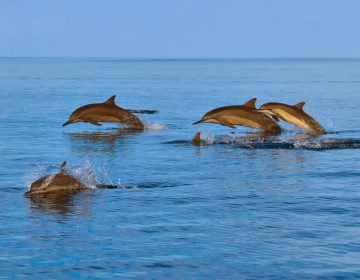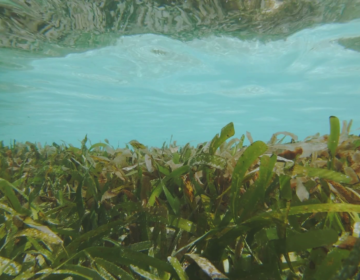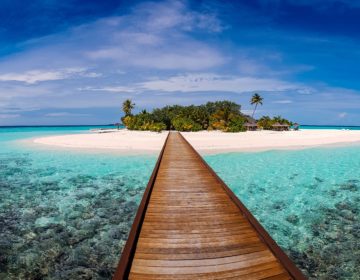Apart from a few air services, there are no regular scheduled transport links between the Maldives atolls and islands. Transfers between the airport and the resorts are arranged by agents as part of the resort package and are by seaplane, helicopter, a local boat called a dhoni, speedboat or launch.
Boats and aircraft can be chartered for special trips, though this is expensive. Not many people need to travel between resorts, but the most straightforward way to do so is usually to go via the airport, taking the same boats or aircraft which carry arriving and departing guests.
Transport to and from the non-resort islands can be arranged on cargo boats, but only by those who have the necessary travel permit. The other option is a ‘safari,’ cruising around the atolls on a live-aboard boat, with whatever stops for diving and sightseeing that the operator can arrange.
Air
Air Maldives has scheduled flights linking five airfields throughout the country, though only Malé and Gan are accessible to visitors without an inter-atoll travel permit. Seaplane and helicopter transfers between Malé and the resorts are not scheduled – they’re more like little charter flights arranged by the resorts and travel agents.
Sea Plane
Seaplane transfers are operated by Maldivian Air Taxi, a Maldivian company managed by Danes, using seaplanes made in Canada. The standard aircraft used are 16-seater DeHavilland Twin Otters, and they take off from the lagoon just east of Malé airport and fly mainly to resorts in Ari Atoll. Usually, they land in a lagoon, tie up to a pontoon and passengers are ferried to their resorts by dhoni. Note that cargo capacity is limited. All passengers and baggage are weighed before loading, and some heavy items may have to wait for a later flight.
Flights are chartered by resorts and tour agents and don’t often take individual passengers. Seaplane transfer costs vary according to the arrangements made by resorts and agents – some deals include the flight at minimal cost, to be more competitive with resorts which are closer to the airport. The cost of transfers is generally included in the package price, but if there is the option of a boat transfer, the seaplane will be charged as an extra. Flights to resorts on Ari Atoll take about 20 minutes, and they’re good fun.
Charter flights for sightseeing, photography and emergency evacuation can be arranged for a price. Maldivian Air Taxi is an efficient and reliable organization, and the pilots are friendly and informative.
 Seaplane transfers are operated by Maldivian Air Taxi
Seaplane transfers are operated by Maldivian Air Taxi
Helicopter
Helicopter transfers fly to all the atolls in the tourist zone, with the shortest connection being 35 km (10 minutes) to Guraidhoo in South Malé Atoll and the longest 152 km (50 minutes) to Kuredo in Lhaviyani Atoll.
They take off from the Malé airport and land at one of 10 heliports around the atolls, and you get to and from the resort by dhoni. The service is usually a charter arranged by resorts and agents, and the costs are included in package price, or charged as an extra if there is an option of sea transport. It’s usually a little cheaper than a seaplane transfer, but this depends on the deal between you and the travel agent, the resort and the helicopter.
Helicopter companies will also do charter flights and emergency evacuations, which can be arranged directly with the company, and 15-minute ‘photo flips’ which can be arranged through many resorts. These can be quite popular, so, if you are interested, it is a good idea to ask at the reception of your resort soon after you arrive. The cost of these flights varies, and sometimes includes the cost of the transfer from your resort to the nearest helipad and back.
 Helicopter companies will also do charter flights and emergency evacuations
Helicopter companies will also do charter flights and emergency evacuations
‘Robinson Crusoe Excursions’
These generally begin at the airport in the morning with a flight to Bodhufolhudhoo in North Ari Atoll. From the helipad, you take a dhoni to a nearby desert island where you have a buffet lunch and spend the day doing whatever you do on a desert island. At the end of the day, the dhoni takes you to the Nika Island Resort & Spa, where you can change before visiting the village of Guraidu and flying back to Malé. Transfers to and from your resort to the airport and back are separate.
 Robinsoe Crusoe Expeditions
Robinsoe Crusoe Expeditions
Sea
You’ll almost certainly spend some of your time in the Maldives on boats. Dive trips and excursions are mostly within the sheltered waters of an atoll and will be very pleasant. If you are transferring from the airport to a resort outside North Malé Atoll, you’ll be crossing much deeper, more open water and it might get a lot rougher.
The departure time and the duration of a trip depend on the weather and sea conditions. Skippers always allow lots of time for a trip and are very cautious. Boats which regularly carry passengers have life jackets, but radios, life rafts, and rescue gear are only installed on fancier boats.
Dhoni
The dhoni is the traditional all-purpose vessel of the Maldives. Dhonis come in various sizes with various superstructures, but the hull is always basically the same shape. Most are now powered with diesel engines, but they often have a sail as a back-up, or to save fuel when the winds oblige.
The basic fishing boat, the mas dhoni, has been modified for use as a short distance ferry between Malé and the airport and to/from nearby resorts and islands. They have a diesel engine, a fabric roof to keep off the sun and the rain, and a wooden bench running down each side. The passengers face each other, and any luggage is stacked down the middle. Most diving trips and island excursions are done on boats like this. If the weather is rough, passengers and luggage can both get wet.
 The dhoni is the traditional all-purpose vessel of the Maldives
The dhoni is the traditional all-purpose vessel of the Maldives
To/From Resorts
Dhonis move at the leisurely pace of around 10 km per hour, but they are fine for transfers to resorts close to the airport. Transfer costs vary depending on the distance, but they are usually included in the basic package price. If the resort is more than 20 km away, then two-and-a-half hours on a hard wooden seat may be a bit too much, especially after a long plane flight. For more distant resorts, there’s usually a faster boat, which may be an option for an additional price, or it may be the only choice.
Dhoni Charters
In Malé, go along the waterfront at the eastern end of Marine Drive, and you’ll find lots of dhonis waiting in the harbor. Most of these are available for charter to the nearby islands. The price depends on where you want to go, and for how long, and on your negotiating skills, and if you’re going to start at 6:00 am and go non-stop for 12 hours, it could be quite a bit more. You can also charter a dhoni at most resorts, but it will cost more and only if they are not being used for excursions or diving trips.
A chartered dhoni will only take you to places you are allowed to go, and the owner or the skipper will be responsible for you. If you want to visit a resort or lunch or day at the beach or whatever, you should call the resort to let them know you’re coming. The dhoni will drop you at the resort jetty, and a security person will greet you. If you want the boat to wait, it will probably have to anchor away from the dock.
From Malé, you’re allowed to go to Kuda Bandos and, if you’re accompanied by someone from your guesthouse or hotel to uninhabited islands in the North and South Malé atolls. If you want to charter a dhoni to another atoll, you’ll have to be invited by someone from that atoll and have an inter-atoll travel permit.

Vedi
A vedi is a large dhoni with a large square-shaped wooden superstructure used for trading between Malé and the outer atolls. Traditionally, sail-powered vedis made trading trips to Sri Lanka, India, Burma, and Sumatra, but these days the vedis are diesel-powered and used only for inter-atoll transport.
 Traditionally, sail-powered vedis made trading trips to Sri Lanka, India, Burma, and Sumatra
Traditionally, sail-powered vedis made trading trips to Sri Lanka, India, Burma, and Sumatra
No vedi will take you as a passenger to an atoll unless you have a permit to go there. To get a permit, you must be sponsored by someone from that atoll, and its best to have that person arrange transport on the vedi. The vedis use Inner Harbor in Malé, west of the fishing harbor. You can tell which atoll a boat comes from by looking at the code letter, which is marked within a square on the bow, next to the registration number:
Haa Alifu (A)
Haa Dhaal (B)
Shaviyani (C)
Noonu (D)
Raa (E)
Baa (F)
Lhaviyani (G)
Kaafu (H)
Alifu (I)
Vaavu (J)
Meemu (K)
Faafu (L)
Dhaalu (M)
Thaa (N)
Laamu (O)
Gaaf Alif (P)
Gaaf Dhaal (Q)
Gnaviyani (R)
Seenu (S)
Travel on a vedi is slow and offers basic food and no creature comforts. Your bunk is a mat on a shelf, the toilet is the sea, and fellow passengers may include chickens. A trip down to Seenu (Addu Atoll), the most southerly and distant atoll, will take at least two hours.
Fast Boats
Resorts which are more than 15 or 20 km from the airport usually offer transfers by speedboats or launches, and costs depend on the distance. This is generally included in the package price unless there is the option of transfer by dhoni, in which case a speedboat is priced as an extra.
The boats can be anything from a small runabout with an outboard motor to a big launch with aircraft type seats and a deafening engine. ZSS on Marine Drive rents out speedboats for up to five passengers. These are expensive with rates that vary depending on the distance of travel and how much time is spent cruising and resorts will also rent out speedboats for similarly high prices.
 Speedboats can be anything from a small runabout with an outboard motor to a big launch with aircraft type seats
Speedboats can be anything from a small runabout with an outboard motor to a big launch with aircraft type seats
Private Yacht
Visiting yachts must go to Malé as soon as they can and clear customs there. If they want to cruise around the Maldives, they must apply to Atolls Administration for a Cruising Permit, which is quite expensive, especially for more than one week. Apart from resort visits, you must sleep on board.
It’s not a popular destination with yachties because of the many dangerous reefs and the restrictions on where a yacht can go. Most resorts don’t welcome yachts, except for Makunadhoo (North Malé Atoll) and Nika (Ari Atoll) might be willing if you call ahead.
Car & Motorcycle
The only places where visitors will need to travel by road are Malé and Addu, one of the southern atolls.
 Most locals in Malé use motorcycles as a mode of transport around the island
Most locals in Malé use motorcycles as a mode of transport around the island
Safari Cruises
If you want to see more of the Maldives than a tourist resort, and particularly if you’re going to move around several different islands and have dive sites all to yourself, a safari cruise might be the best way to go. The number of companies offering safari trips has increased considerably in recent years, and some are undoubtedly better than others.
The standard of boats varies widely, as does the cost of chartering them. The most basic ones are large dhonis with six berths in two or three cramped cabins and a small communal diving area. A small boat will have six passenger berths, and a large one will have as many as 14. The biggest and best boats are like mini cruise ships with spacious cabins, a comfortable dining room, lounge and bar, Jacuzzi and onboard dive base. Costs vary according to the size and luxury level of the boat, and it’s cheaper per head if there are enough passengers to fill the boat. You may be charged extra for soft drinks, or for alcohol if it’s one of the better boats, and you may have to pay extra for the occasional meal at a resort, but generally, there are few extras to spend money on.
Accommodation on a safari boat is usually in very small cabins, with showers and toilets shared between a couple of booths. The bigger better boats have air-conditioning and slightly more spacious accommodations. On more basic ones, the passengers often drag their mattresses out on deck for fresh air and a bit more elbow room. On some trips, there may be a camp out on an uninhabited island. Food is prepared on board and varies from very ordinary to very good.
A potential problem, especially on longer sightseeing cruises, is the compatibility of the group. If you are confined to a small boat, and you can’t stand half the people on board, a 10-day trip could become a real ordeal. Operators try to match the passengers regarding age, nationality, and language, but that isn’t always possible. It’s best if you can arrange your own group of six or so people who get along well and share interests.
 The larger dhonis have six berths in two or three small cabins and a small communal diving area
The larger dhonis have six berths in two or three small cabins and a small communal diving area
Diving Safaris
On diving trips, compatibility is less of a problem as most of the passengers share a common interest in diving. Everyone on a diving safari should be a qualified diver. Dive clubs can often get together enough members to fill a safari boat and design an itinerary which suits their needs.
Diving safaris usually have a separate dhoni which follows the main boat and has the compressor and most of the equipment on board. This means that compressor noise doesn’t disturb passengers at night, and the smaller boat can be used for excursions in shallower water.

Itineraries and Permits
Most safaris trips make a loop through the tourist atolls. The shorter, seven-day trips will take in North and South Malé Atolls and Ari Atoll, possibly including Rasdhoo. A 14-day trip may also go south to Felidhoo Atoll or north to Baa and Lhaviyani atolls. To get a safari trip outside the tourist zone, the operator is required to get Inter-Atoll Travel Permits for all the passengers. These would have to be arranged in advance and would cost more.
If it’s intended ‘to dive in historically noted sites that may contain ancient artifacts,’ the trip may need permission from the relevant government authority, which could be difficult. The usual Inter-Atoll Travel Permit is not for visits to uninhabited islands, so if you hope to look at any archaeological sites on remote islands, you should make sure that the safari operator can get the necessary permission.
You may have to spend a night in Malé before or after your trip, which should be regarded as an interesting bonus. Click here to find a fantastic hotel in Malé.



